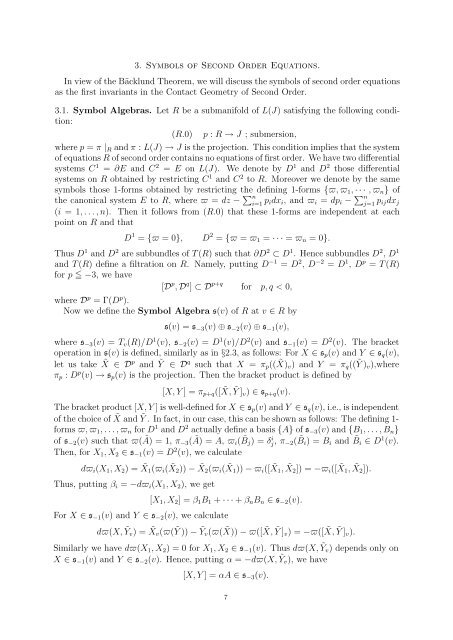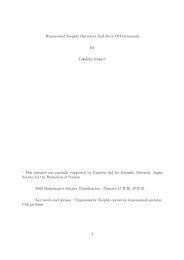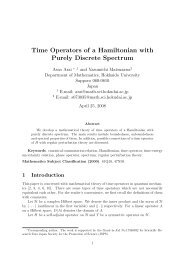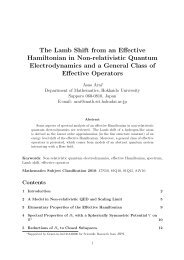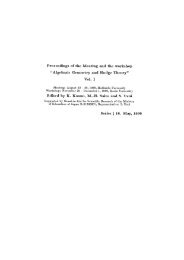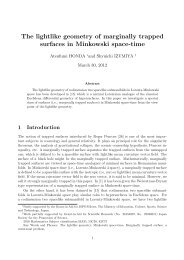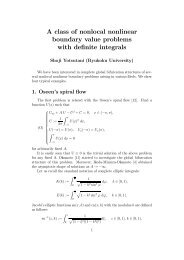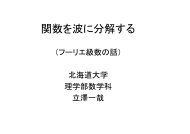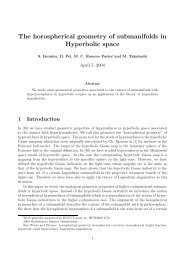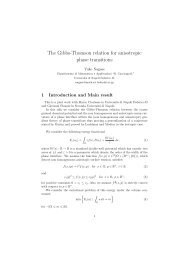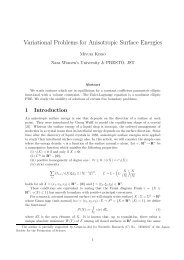Contact Geometry of second order I - Dept. Math, Hokkaido Univ ...
Contact Geometry of second order I - Dept. Math, Hokkaido Univ ...
Contact Geometry of second order I - Dept. Math, Hokkaido Univ ...
Create successful ePaper yourself
Turn your PDF publications into a flip-book with our unique Google optimized e-Paper software.
3. Symbols <strong>of</strong> Second Order Equations.<br />
In view <strong>of</strong> the Bäcklund Theorem, we will discuss the symbols <strong>of</strong> <strong>second</strong> <strong>order</strong> equations<br />
as the first invariants in the <strong>Contact</strong> <strong>Geometry</strong> <strong>of</strong> Second Order.<br />
3.1. Symbol Algebras. Let R be a submanifold <strong>of</strong> L(J) satisfying the following condition:<br />
(R.0) p : R → J ; submersion,<br />
where p = π |R and π : L(J) → J is the projection. This condition implies that the system<br />
<strong>of</strong> equations R <strong>of</strong> <strong>second</strong> <strong>order</strong> contains no equations <strong>of</strong> first <strong>order</strong>. We have two differential<br />
systems C 1 = ∂E and C 2 = E on L(J). We denote by D 1 and D 2 those differential<br />
systems on R obtained by restricting C 1 and C 2 to R. Moreover we denote by the same<br />
symbols those 1-forms obtained by restricting the defining 1-forms {ϖ, ϖ1, · · · , ϖn} <strong>of</strong><br />
the canonical system E to R, where ϖ = dz − ∑ n<br />
i=1 pidxi, and ϖi = dpi − ∑ n<br />
j=1 pijdxj<br />
(i = 1, . . . , n). Then it follows from (R.0) that these 1-forms are independent at each<br />
point on R and that<br />
D 1 = {ϖ = 0}, D 2 = {ϖ = ϖ1 = · · · = ϖn = 0}.<br />
Thus D 1 and D 2 are subbundles <strong>of</strong> T (R) such that ∂D 2 ⊂ D 1 . Hence subbundles D 2 , D 1<br />
and T (R) define a filtration on R. Namely, putting D −1 = D 2 , D −2 = D 1 , D p = T (R)<br />
for p ≦ −3, we have<br />
[D p , D q ] ⊂ D p+q<br />
for p, q < 0,<br />
where D p = Γ(D p ).<br />
Now we define the Symbol Algebra s(v) <strong>of</strong> R at v ∈ R by<br />
s(v) = s−3(v) ⊕ s−2(v) ⊕ s−1(v),<br />
where s−3(v) = Tv(R)/D 1 (v), s−2(v) = D 1 (v)/D 2 (v) and s−1(v) = D 2 (v). The bracket<br />
operation in s(v) is defined, similarly as in §2.3, as follows: For X ∈ sp(v) and Y ∈ sq(v),<br />
let us take ˜ X ∈ D p and ˜ Y ∈ D q such that X = πp(( ˜ X)v) and Y = πq(( ˜ Y )v),where<br />
πp : D p (v) → sp(v) is the projection. Then the bracket product is defined by<br />
[X, Y ] = πp+q([ ˜ X, ˜ Y ]v) ∈ sp+q(v).<br />
The bracket product [X, Y ] is well-defined for X ∈ sp(v) and Y ∈ sq(v), i.e., is independent<br />
<strong>of</strong> the choice <strong>of</strong> ˜ X and ˜ Y . In fact, in our case, this can be shown as follows: The defining 1forms<br />
ϖ, ϖ1, . . . , ϖn for D 1 and D 2 actually define a basis {A} <strong>of</strong> s−3(v) and {B1, . . . , Bn}<br />
<strong>of</strong> s−2(v) such that ϖ( Ã) = 1, π−3( Ã) = A, ϖi( ˜ Bj) = δ i j, π−2( ˜ Bi) = Bi and ˜ Bi ∈ D 1 (v).<br />
Then, for X1, X2 ∈ s−1(v) = D 2 (v), we calculate<br />
dϖi(X1, X2) = ˜ X1(ϖi( ˜ X2)) − ˜ X2(ϖi( ˜ X1)) − ϖi([ ˜ X1, ˜ X2]) = −ϖi([ ˜ X1, ˜ X2]).<br />
Thus, putting βi = −dϖi(X1, X2), we get<br />
[X1, X2] = β1B1 + · · · + βnBn ∈ s−2(v).<br />
For X ∈ s−1(v) and Y ∈ s−2(v), we calculate<br />
dϖ(X, ˜ Yv) = ˜ Xv(ϖ( ˜ Y )) − ˜ Yv(ϖ( ˜ X)) − ϖ([ ˜ X, ˜ Y ]v) = −ϖ([ ˜ X, ˜ Y ]v).<br />
Similarly we have dϖ(X1, X2) = 0 for X1, X2 ∈ s−1(v). Thus dϖ(X, ˜ Yv) depends only on<br />
X ∈ s−1(v) and Y ∈ s−2(v). Hence, putting α = −dϖ(X, ˜ Yv), we have<br />
[X, Y ] = αA ∈ s−3(v).<br />
7


